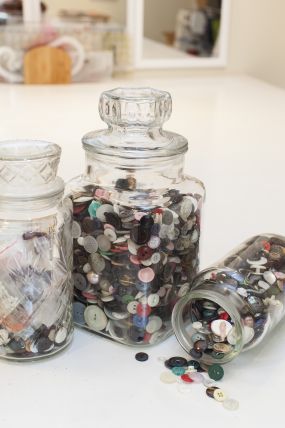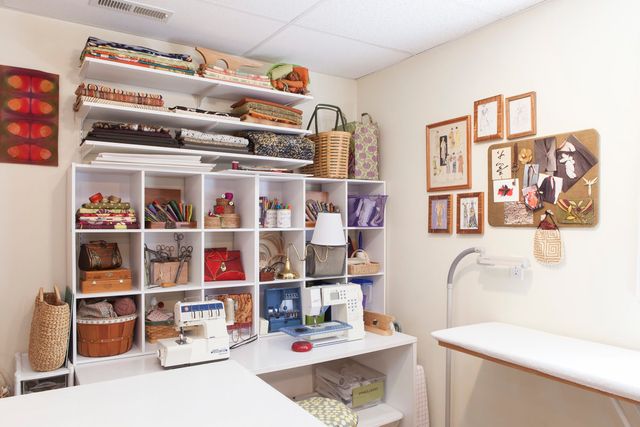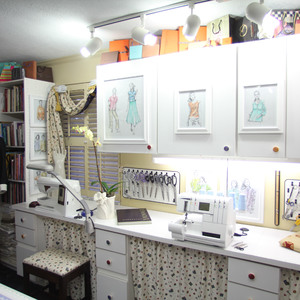
Mary loves that she gets to spend so much time in her inspirational sewing room.
In Threads #175, our contributing editor Mary Ray shared her favorite methods for storing fabrics, notions, and thread in her North Carolina sewing studio. While keeping things neatly stored is important, she also likes leaving certain items out in the open so she knows what she has to work with. Below is an inside look at Mary’s studio.
 Take a look at more sewing studios and spaces:
Take a look at more sewing studios and spaces:
• Ruth Ciemnoczolowski’s Sewing Room
• Inside Louise Cutting’s Sewing Room
• Another Look at Kenneth D. King’s Sewing Space
• Helen Haughey’s Favorite Tools and Storage Solutions
Here you will notice that Mary’s workspace is filled with plenty of storage space and inspiration.

Decorative threads are stored by type in wooden wine boxes while Mary’s all-purpose threads are kept in shallow drawers. Some of the thread types shown here include: variegated, embroidery, cotton Aurifil, 12-weight cotton, Sulky, silk, and rayon.

Below Mary models her textured silk top (Vogue 8536) with pressed-in pleats. See how she created the dimension on this lovely top here.

Mary loves her Delonghi steam generator iron because it has a heavy, professional soleplate. It can also be set for continuous steam, which she says is very useful when pressing large pieces of fabric.

Fabrics and notions are stored on shelves and in cubes so Mary can see what materials she has at all times.

This inspiration board is currently decorated with images and objects Mary finds interesting.

An assortment of straight and curved rulers remains at Mary’s 72-inch by 45-inch cutting table at all times.

One table is obviously not enough, which is why Mary uses this second table as her “overflow” table.

Mary has been collecting buttons for years and believes everyone should have a button jar. Some of the buttons below date back to her grandmother and mother. She generally stores her current buttons in plastic drawers and boxes.

Design, fabric, and pattern-making books are easily accessible in Mary’s studio. Still, she has four additional bookshelves filled with sewing-related books in another room nearby, which she calls her “spillover” room.

What’s your favorite part about Mary’s sewing room? Do you tend to accumulate certain sewing notions more than others? Please share your comments below!










































I am very inspired by Mary's studio. While I have vast collection of fabrics, like Mary, I also have a collection of buttons that date back to my great grandmother who taught me to sew many years ago. Thanks to Mary I will be doing a better job of organizing my sewing.
Mary, I love your room. How do you keep the dust off of your open shelves?
Oh I wish I hade a whole room for my sewing!
I agree with Mary...one table surface is definitely not enough. Recently I rearranged my sewing studio so that I have three flat surfaces and it has vastly improved my efficiency while working on projects. I rarely "lose" my scissors, marking pen, pins, etc. under a pile of stuff. And everything is right at hand within easy reach.
Wonderful space and I have to mention, what a beautiful portrait of Mary! The blouse is a stunner as is it's wearer.
Beautiful studio Mary !
I like yur studio mary!
I truly love all the white and that is what I want to do with mine. I love seeing all my fabric stach and just hate having to keep in clear plastic boxes. I love all the cube features you have. Looks so inviting to sew and create.
Thanks for letting us into your special space, Mary. I find as I have aged that I need more light for seeing details in my projects. How have you handled lighting in your sewing room? Barbara Hewitt asked an interesting question - how DO you keep the dust off of the open shelfs?
My question is also about dust. I recently put most of my fabrics on an open shelf (sorry no picture yet) and in the interim of finding a permanent fix for dust, I have a removal sheet of painters plastics that I remove and replace as needed. The kicker is, it is so wonderfully inspiring to see the fabrics, I can never go back to plastic containers. I too have buttons that were my Mom's from the 50's.
I loved seeing Mary's wonderful studio. Thanks, Mary! And aprongirl, my alternative to fabric on open shelves is steel shelving on wheels, inside a large hall closet. Open the closet to see all the dust-free fabric! My husband has another idea if you don't have the closet space. Construct sliding panels to cover your existing shelves. You could have separate panels for one or two shelves or one panel for top to bottom of the shelf case. They slide past each other like glass sliding doors.